
At the end of my first few Evolution articles, I asked readers to tell me if they wanted to know how some of their favorite non-character cards evolved from my original concept all the way to the final card. I received several emails, and below are the cards that you (at least some of you) wanted to see. They are naturally the more powerful and popular cards, so your favorite card is probably below.
Key
Original: November 2004. By the middle of this month, I had given each character in the set a “first pass” power. These were heavily thematic powers that helped me to see where team themes might present themselves.
Turnover: March 8, 2005. This is the day I turned over my design file to the developers.
Development: April 19, 2005—a week after ally became what you see today. Sometimes the development team made changes. Sometimes, they came to me asking for a rewrite.
Final: This is the text you see on the card today.
Secret Sanctuary
Original
 “Activate >>> Target JLA character you control cannot be targeted by character or location powers opponents control this phase.”
“Activate >>> Target JLA character you control cannot be targeted by character or location powers opponents control this phase.”
From the outset, I wanted to give the team some control elements.
Turnover
“While you control a ready JLA character, you can’t be targeted by effects opponents control. <p> Exhaust a character you control >>> That character gets +1 willpower this turn.”
Instead of making it so specific, I thought it might be fun to give the player the protection. Not sure what I had in mind with that willpower increase.
Development
“Flip Secret Sanctuary only during your formation step and only if you control a JLA character. <p> During each opponent’s first attack in which he controls an attacker, that opponent may not play plot twists or use payment powers.”
Look familiar? It became Field of Honor. Thematically, the Sanctuary should be doing something a little more like a base.
Final
“Activate, exhaust any number of JLA characters you control >>> Return target character card from your KO’d pile to your hand if its cost is less than or equal to the total willpower of the characters you exhausted.”
Finding teammates is a classic base ability, and this one works well with the willpower part of the team.
Reform the League
Original
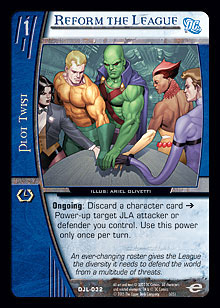 “You may move each JLA character you control. If you played Reform the League from your resource row, you may replace it.”
“You may move each JLA character you control. If you played Reform the League from your resource row, you may replace it.”
With a name like Reform, I thought it might be fun to reform your formation. But this card wasn’t doing enough.
Turnover
“You may move any number of characters you control. <p> If you played Reform the League from your resource row and you control a JLA character, draw a card.”
I thought that taking off the team stamp would help. It didn’t.
Development
“Power-up target JLA attacker or defender you control. <p> You may move that character.”
I revised it early in development when ally was in the picture. This card eventually became Magnificent Seven after a few improvements.
Final
“Ongoing: Discard a character card >>> Power-up target JLA attacker or defender you control. Use this power only once per turn.”
I like this a lot because it plays well with Disband the League. After all, you can’t reform unless you’ve already disbanded.
Kooey Kooey Kooey
Original
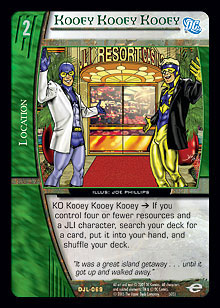 “At the start of your recruit step, gain 1 resource point. You may only use this point to pay for payment powers.”
“At the start of your recruit step, gain 1 resource point. You may only use this point to pay for payment powers.”
As you’ve read before, I originally wanted the JLI to use resource points like the Masters of Evil.
Turnover
“Activate, discard a JLI character card >>> Gain 1 resource point. You cannot use this resource point to recruit. Use this power only during your recruit step.”
I figured that just gaining 1 resource point for free might be a bit good.
Development and Final
“KO Kooey Kooey Kooey >>> If you control four or fewer resources and a JLI character, search your deck for a card, put it into your hand, and shuffle your deck.”
This card was changed to fit the 4 or less resources theme and made it all the way through development unchanged.
Staged Attack
Original
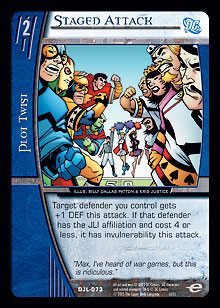 “Ready target JLI defender with cost 4 or less you control.”
“Ready target JLI defender with cost 4 or less you control.”
I wanted a card that gave you some cool cookie for making an attack seem, well . . . staged. Maxwell Lord got the JLI recognition by staging attacks for them to thwart. However, this card was too narrow and would force me to add lots of activated powers to the team just so it could do something.
Turnover
“During the first attack this turn, players may not play plot twists or use payment effects. Play Staged Attack only during your formation step and only if you control a JLI character.”
I had this power in several places already. I guess I liked how it sped up the game! This worked on attack or defense, and neither player could play stuff. A modified version eventually appeared on Field of Honor.
Development
“Ongoing: Whenever one or more JLI team attackers you control stuns a defender, you may reveal the top three cards of your deck. If you do, choose one character card from among them and put it into your hand. Put the remaining cards on the bottom of your deck in any order.”
Now I’m visiting the JLI team attack theme but have gone away from the staged attack theme. Now the JLI is attacking . . .
Final
“Target defender you control gets +1 DEF this attack. If that defender has the JLI affiliation and cost 4 or less, it has invulnerability this attack.”
Sometimes simple is best. Now your opponent is the unwary attacker. You might survive the attack. If you don’t, at least you won’t be hurt much by it.
Bwa Ha Ha Ha Ha!
Original and Turnover
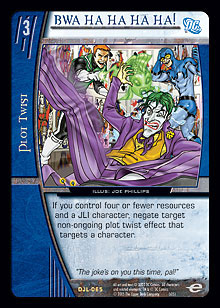 “Negate target non-ongoing plot twist effect with cost higher than the number of resources you control. Play BWA HA HA HA HA! only if you control a JLI character.”
“Negate target non-ongoing plot twist effect with cost higher than the number of resources you control. Play BWA HA HA HA HA! only if you control a JLI character.”
I really liked my original, so I shipped it to the development team. The problem with this was that even if you stuck to the 4 or less theme of the team, it wouldn’t negate much; ninety-five percent of all plot twists have a threshold of 4 or less.
Development
“Play BWA HA HA HA HA! only if you control a JLI character and only if you control four or fewer resources. <p> Negate target non-ongoing plot twist effect.”
This proved way too good as search negation, as there was no restriction on the type of plot twist it could negate.
Final
“If you control four or fewer resources and a JLI character, negate target non-ongoing plot twist effect that targets a character.”
Now it is restricted to negating just plot twists that target a character. Could be your character, could be mine.
Royal Egg-Matrix
Original
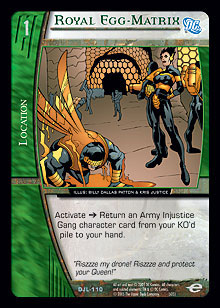 “Characters named Bee-Trooper you control have flight and range. <p> Activate >>> Put a 1 ATK / 1 DEF Bee-Trooper character token into your front or support row.”
“Characters named Bee-Trooper you control have flight and range. <p> Activate >>> Put a 1 ATK / 1 DEF Bee-Trooper character token into your front or support row.”
My original idea had Queen Bee and the Matrix creating scraps of paper called Bee-Troopers.
Turnover
“While you control an Injustice Gang character, characters named Insectoid Troopers you control have flight. <p> Activate >>> Return target character card named Insectoid Troopers from your KO’d pile to your hand.”
At this point, Insectoid Troopers were unaffiliated 1-drops that didn’t fly.
Development
“Activate >>> Return an Army Injustice Gang character card from your KO’d pile to your hand.”
By now, they had flight, so the text was getting shorter but not short enough.
Final
“Activate >>> Return an Army Injustice Gang character card from your KO’d pile to your hand.”
By now, the Army characters in the set were on the Injustice Gang, so why not make the text shorter and make the card useful even if you didn’t control an I-Ganger.
Criminal Mastermind
Original
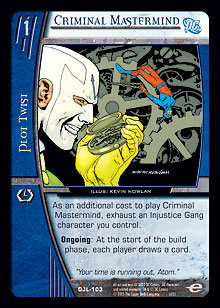 “Play only if you control an Injustice Gang character. <p> Ongoing: At the start of the draw phase, return a card from your removed-from-game pile to your hand.”
“Play only if you control an Injustice Gang character. <p> Ongoing: At the start of the draw phase, return a card from your removed-from-game pile to your hand.”
Early deck depletion between both villain teams was removing a lot of cards from your deck to the removed-from-game pile.
Turnover
“Ongoing: Whenever an Injustice Gang character you control becomes stunned, you may look at the top card of your deck. Put that card on top of your deck or into your KO’d pile.”
I was thinking it would make for a great draw improvement engine, but it would have been more of a time waster.
Development and Final
“As an additional cost to play Criminal Mastermind, exhaust an Injustice Gang character you control. <p> Ongoing: At the start of the draw phase, each player draws a card.”
When the “tax” theme of the team focused on drawing cards, this card was overhauled. I really like the synergy of this card, as it’s needed in both the Army deck and the hand-flood theme of team; both decks need to draw lots of cards to do well.
Infestation
Original
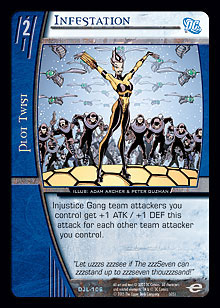 “As an additional cost to play Buy The Same, discard an Injustice Gang character card. Put a copy of target token character into your front row.”
“As an additional cost to play Buy The Same, discard an Injustice Gang character card. Put a copy of target token character into your front row.”
This was during my scrap-of-paper token character days. The placeholder name for this card was a pun, and actually kind of a double pun; I switched up the saying “by the same token” to call the card “Buy The Same,” well, ’cause you’re buying the same token that you already have. Yeah.
Turnover
“As an additional cost to play Infestation, discard an Injustice Gang character card. <p> Search your deck for a character card named Insectoid Troopers and put it into your front row. Shuffle your deck.”
Look familiar? Check out Conscription.
Development
“Play Infestation only during your recruit step. <p> As an additional cost to play Infestation, discard a card. <p> Search your deck for an Injustice Gang Army character card with cost 1, put it into your front row, and shuffle your deck.”
Now it features a recruit step restriction. It might have been too good to be able to do it anytime.
Final
“Injustice Gang team attackers you control get +1 ATK / +1 DEF this attack for each other team attacker you control.”
I wanted to give the Insectoid Troopers (or any of the Gang’s Army characters) a fighting chance. This can get pretty sick when you have a handful of team attackers.
Sinister Citadel
Original
 “Activate >>> Put a character card from your KO’d pile on the bottom of your deck.”
“Activate >>> Put a character card from your KO’d pile on the bottom of your deck.”
If the theme was to run out of cards, putting a specific character on the bottom of your deck was essentially searching for that character and drawing it the next turn.
Turnover
“Activate >>> Target Secret Society defender you control gets +2 ATK and an additional +2 ATK if there are no cards in your deck.”
Realizing that any card that only did something when your deck was gone would be awful for the first five turns of the game, I decided to give “cookies” when your deck was depleted. I originally wanted to abbreviate the team SSS. Glad we didn’t.
Development
“KO a character you control >>> Put a +1 ATK / +1 DEF counter on target Secret Society leader you control. Use this power only once per turn. <p> Activate >>> Remove a +1 ATK / +1 DEF counter from a character you control. If you do, put a +1 ATK / +1 DEF counter on another character you control.”
When I severely scaled back the number of “no deck” effects, I retooled some of them into the set’s villainous counter theme.
Final
“Sinister Citadel is not unique. <p> KO a character you control >>> Put a +1 ATK / +1 DEF counter on target leader character you control. Use this power only once per turn. <p> Activate >>> Remove a +1 ATK / +1 DEF counter from a character you control. If you do, put a +1 ATK / +1 DEF counter on target Secret Society character you control.”
It’s a pretty subtle difference between the development and final versions. I wanted the KO cost to be more generically useful, partially as a defense against the character stealing effects. Sometimes, the best cards to use against a team are on that team (*cough* Ocean Master).
Slaughter Swamp
Original
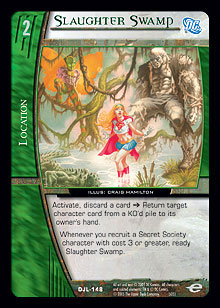 “Activate, discard two Secret Society character cards >>> KO target stunned character.”
“Activate, discard two Secret Society character cards >>> KO target stunned character.”
With the word Slaughter in the name, I figured it’d make for a good KO card.
Turnover
“Activate, remove the top XX cards of your deck from the game >>> If at least one of the cards has the Secret Society affiliation, KO target stunned character with cost X.”
As part of the deck depletion theme, this would be a quick and dirty way to get rid of your deck.
Development
“Activate, put X cards from your KO’d pile on the bottom of your deck >>> KO target stunned character with cost X. Use this power only if you control a Secret Society character and only if there are ten or more cards in your KO’d pile.”
The deck depletion theme was scaled back and cards were going to the KO’d pile instead of being removed from the game, so here was a way to use them.
Final
“Activate, discard a card >>> Return target character card from a KO’d pile to its owner’s hand. <p> Whenever you recruit a Secret Society character with cost 3 or greater, ready Slaughter Swamp.”
But in the end, the deck needed a reliable way to get characters back out of the KO’d pile that was different from the weenie enabling Attend or Die!
Attend or Die!
Original
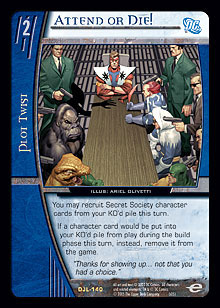 “Ongoing: At the start of the draw phase, if there are no cards in your deck, return target card in the removed-from-game zone to your hand.”
“Ongoing: At the start of the draw phase, if there are no cards in your deck, return target card in the removed-from-game zone to your hand.”
And this is that other recruiter. Sadly, this card was a great reward but offered no way to make it happen.
Turnover
“Ongoing: Discard a card >>> You may recruit Secret Society character cards in your removed-from-game zone as if they were in your hand this turn. (Character cards in the removed-from-game zone have only their team affiliations.)”
This one was geared much more toward the weenie side of the team. It was the one that wanted to make sure that Funky Flashman and Lex Luthor, Criminal Genius always had three adjacent characters.
Development and Final
“You may recruit Secret Society character cards from your KO’d pile this turn. <p> If a character card would be put into your KO’d pile from play during the build phase this turn, instead, remove it from the game.”
The reason for the second sentence is that it only took one day for the development team to find a broken combo . . . which I’m not going to share with you, thanks.
Sorcerer’s Treasure
Original
 “Put target card in the removed-from-game zone into your hand. <p> If there are one or more cards in your deck, discard a card.”
“Put target card in the removed-from-game zone into your hand. <p> If there are one or more cards in your deck, discard a card.”
If you’re removing all your cards from the game, you need a way to get to them. Both villain teams did it a bit early on, so this was a generic version.
Turnover
“As an additional cost to play Sorcerer’s Treasure, discard two cards or one Secret Society character card. <p> Put target card from your removed-from-game zone into your hand.”
The idea was to let anyone use it but let the Society do it better.
Development and Final
“As an additional cost to play Sorcerer’s Treasure, discard a Secret Society character card. <p> Choose a plot twist in your KO’d pile. You may play that card from your KO’d pile this turn. Whenever you do, remove that card from the game.”
Nah, better make it Society only and forget about that whole removed from game thing.
Death Times Five
Original
 “Whenever target character you control causes breakthrough this turn, each of your opponents loses 5 endurance. Play Death Times Five only during the build phase.”
“Whenever target character you control causes breakthrough this turn, each of your opponents loses 5 endurance. Play Death Times Five only during the build phase.”
The title comes from the “Secret Society of Supervillains Special Issue,” printed in 1977. But tacking on essentially extra breakthrough is just a bad Surprise Attack.
Turnover
“Whenever target attacker would cause breakthrough to a player this attack, that player loses 5 endurance instead.”
This proved way too good in hidden decks, as it could reduce a direct attack to 5 endurance loss.
Development
“Whenever target attacker would cause breakthrough while attacking a defender this turn, instead, that defender’s controller loses 5 endurance.”
I like the fact that it uses both directions. Want to cause 5 breakthrough instead of less than that? Want to only take 5 instead of 14?
Final
“If target attacker would cause breakthrough while attacking a character this turn, instead, that character’s controller loses 5 endurance.”
Crisis on Infinite Earths
Original
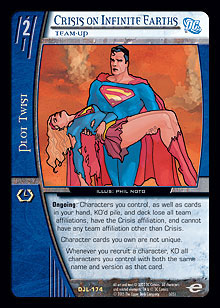 “As an additional cost to play Crisis on Infinite Earths, discard a card. <p> Target opponent stuns a character he controls that shares a name with another character he controls. <p> Play Crisis on Infinite Earths only if an opponent controls two or more non-Army characters with the same name.”
“As an additional cost to play Crisis on Infinite Earths, discard a card. <p> Target opponent stuns a character he controls that shares a name with another character he controls. <p> Play Crisis on Infinite Earths only if an opponent controls two or more non-Army characters with the same name.”
Thematically, I liked the idea of a card that could get rid of duplicate characters of a certain name. But it doesn’t ever happen often enough to put in a deck.
Turnover
“Ongoing: Affiliated characters you control, as well as cards in your hand, KO’d pile, and deck lose all team affiliations and gain the Crisis affiliation. <p> Crisis attackers you control get +1 ATK while attacking characters with a higher cost. <p> Crisis defenders you control get +1 ATK while defending against characters with a higher cost.”
Now Crisis is a team affiliation that is adept at fighting bigger characters. However, this could allow the flipping of a new Team-Up afterward to add a team affiliation; too many potential broken combos.
Development
“Ongoing: Characters you control, as well as cards in your hand, KO’d pile, and deck lose all team affiliations, have the Crisis affiliation, and cannot gain any team affiliation other than Crisis. <p> Characters you control are not unique.”
There. Now you can’t gain other affiliations. Unfortunately, this still allowed you to have multiple copies of Puppet Master and other annoying characters.
Final
“Ongoing: Characters you control, as well as cards in your hand, KO’d pile, and deck lose all team affiliations, have the Crisis affiliation, and cannot have any team affiliation other than Crisis. <p> Character cards you own are not unique. <p> Whenever you recruit a character, KO all characters you control with both the same name and version as that card.”
All fixed. Now if you really want both Dr. Dooms in play and shut off your opponent’s plot twists, you have to play the 4-drop Doom on turn 7 and flip Crisis face down. Okay, fine, have that one.
And so comes to a close the never-ending series of Evolution articles. Thanks for your requests on cards to write about for this article; I hope your favorite cards were as interesting to read about as they were to dream up. After the holiday break, I’ll be back with all new insights, stories, and half-truths about the creation of the Justice League of America set.
Send questions or comments to mhyra@metagame.com.